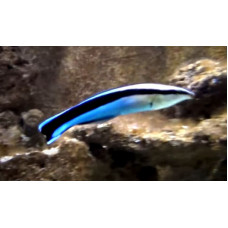Latin name
Labroides dimidiatus
Other names
Labroides dimidiatus
Identification
Genetic analysis of L. dimidiatus has shown that the population is divided into two monophyletic groups, with Indian Ocean populations generally having different band widths compared to fishes in the western Pacific. However, the Japanese cleaner wrasse belong to the same group as the Indian Ocean fishes, despite differences in appearance, and the two clades overlap in Papua New Guinea. Two closely related species of cleaner wrasse, Labroides pectoralis and Labroides bicolor, have been grouped together in the L. dimidiatus clade, so the bluestreak cleaner wrasse may actually be polyphyletic, comprising several species.
Features of fish fins
Dorsal spines (total): 9; Dorsal soft rays (total): 10-11; Anal spines: 3; Anal soft rays: 10.
Fish colouring
These fish can be recognized by a broad longitudinal black stripe running down the flank and around the eyes; the back and belly are white (sometimes slightly yellowish). From the front, this white part of the body transitions to bright blue, and the black stripe on the tail widens. Cubs are black with a pale blue stripe.
Distribution
Widespread in the tropics from the Red Sea and Indian Ocean to the western Pacific (including Papua New Guinea, Japan, Fiji and French Polynesia).
Habitat
Marine tropical non-migratory species. Occurs in coral-rich areas of inland lagoons and coastal reef shoals to ocean-facing reefs. Depth range from 0 to 100 m, usually 1 to 30 m.
Size
It is a small wrasse, averaging 10 cm in length, with a maximum of 14 cm. Maximum reported age: 4 years.
BehaviorBluestreak cleaner wrasses clean fish of ectoparasites and use them as food. Larger fish will recognize the cleaner by the lateral stripe along their body and by their movement patterns. After recognizing the cleaner and successfully attracting its attention, the client fish will assume a pose characteristic of its species to allow the cleaner access to its body surface, gills, and sometimes its mouth. These fishes are known to clean Balaenopteridae, Chondrichthyans, Homaridae, Octopodidae, and Dermochelyidae.
Food and feeding habits
Feeds on ectoparasites, crustaceans and the slime of other fish.
Reproduction
Monogamous. Primordial hermaphrodites. Bidirectional sex change has been confirmed in this species. Lay eggs, mate differentially during reproduction. Spawn pelagically. Sex change occurs after 14-18 days. Monadic species. Length at sex change = 8.8 cm. Monogamous mating is considered both facultative and social, with males defending specific habitat territories from other males where they can control females. When the dominant male is no longer in the territory, one of the larger females may change sex to take control of the territory.
Fishing
Not interesting for fishing. Small numbers are caught for sale to aquariums.
Relationship with a person
The Bluestreak cleaner wrasse is a harmless species to humans.
| Classification | |
| Phylum | Chordata |
| Class | Actinopterygii |
| Squad | Labriformes |
| Family | Labridae |
| Genus | Labroides |
| Species | L. dimidiatus |
| Features | |
| Conservation status | Least Concern |
| Habitat | Pelagic |
| Life span, years | 4 |
| Maximum body weight, kg | No information |
| Maximum length, cm | 14 |
| Sailing speed, m/s | No information |
| Threat to people | Not edible |
| Way of eating | Planktonophage |



